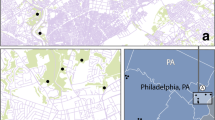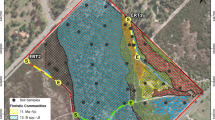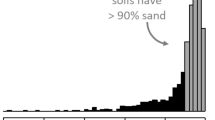Abstract
Previous studies at the scale of a city have shown that surface soil nutrients, pH, and soil organic matter (SOM) can vary by land cover, land use, and management. This study was conducted in Baltimore County, Maryland, to quantify the differences in characteristics of soil in a residential neighborhood and adjacent forest patch sampling at a fine scale. The first objective was to compare soil characteristics in a residential neighborhood among ecotope types of forest, lawn, and planting beds that were underlain by the same parent material and thus only differed in plant cover. Another objective was to examine differences in soil properties of lawn soils that differed in age by 10 years. The final objective was to quantify the variation of these residential and forest soils. Composite soil samples from the surface to a depth of 5 cm were taken from planting beds and lawns from 50 residences and an adjacent forest patch. Results showed that the forest soil had 30 % more SOM and was more acidic than lawn soil. Conversely, Mg, P, K, and Ca were 47 to 67 % lower in forest compared to lawn soils even though both soils developed from similar parent materials. For the residential lawns, the older development had significantly higher concentration of soil P. There was also a difference between front and back lawns where front lawns had 26 and 10 % higher concentrations of Ca and Mg, respectively, and a higher pH than the back lawns. Finally, the variation of soil characteristics of all areas sampled, from lowest to highest was pH < SOM < K < Mg < Ca < P. Results of this study suggest that anthropogenic factors appear to overwhelm natural soil forming factors in suburban residential areas in the Baltimore metropolitan area and these differences appear to increase with time.





Similar content being viewed by others
References
Baltimore County (2011) Introduction to Baltimore County. http://www.baltimorecountymd.gov/Agencies/economicdev/baltimorecountybusiness/qualityoflife/baltimorecountyintroindex.html. Accessed 10 November 2015
Bennett EM (2003) Soil phosphorus concentrations in Dane County, Wisconsin, USA: an evaluation of the Urban-Rural gradient paradigm. Environ Manag 32:476–487
Bennett EM, Carpenter SR, Clayton MK (2005) Soil phosphorus variability: scale-dependence in an urbanizing agricultural landscape. Landsc Ecol 20:389–400
Bloemen ML, Markert B, Lieth H (1995) The distribution of Cd, Cu, Pb, and Zn in topsoils of Osnabruck in relation to land-use. Sci Total Environ 166:137–148
Buol SW, Hole FD, McCracken RJ (1989) Soil genesis and classification, 3rd edn. Iowa State University Press, Ames
Cook EM, Hall SJ, Larson KL (2012) Residential landscapes as social-ecological systems: a synthesis of multi-scalar interactions between people and their home environment. Urban Ecosyst 15:19–52
Corre MD, Schnabel RR, Shaffer JA (1999) Evaluation of soil organic carbon under forests, cool-season and warm-season grasses in the northeastern US. Soil Biol Biochem 31:1531
Ellis EC, Li RG, Yang LZ, Cheng X (2000) Long-term change in village-scale ecosystems in china using landscape and statistical methods. Ecol Appl 10:1057–1073
Ellis EC, Wang HQ, Xiao HS, Peng K, Liu XP, Li SC, Ouyang H, Cheng X, Yang LZ (2006) Measuring long-term ecological changes in densely populated landscapes using current and historical high resolution imagery. Remote Sens Environ 100:457–473
Foley JA, DeFries R, Asner GP, Barford C, Bonan G, Carpenter SR, Chapin FS, Coe MT, Daily GC, Gibbs HK, Helkowski JH, Holloway T, Howard EA, Kucharik CJ, Monfreda C, Patz JA, Prentice IC, Ramankutty N, Snyder PK (2005) Global consequences of land use. Science 309:570–574
Golubiewski NE (2006) Urbanization increases grassland carbon pools: effects of landscaping in Colorado’s front range. Ecol Appl 16:555–571
Gough CM, Elliott HL (2012) Lawn soil carbon storage in abandoned residential properties: an examination of ecosystem structure and function following partial human-natural decoupling. J Environ Manag 98:155–162
Hagan D, Dobbs C, Timilsina N, Escobedo F, Toor GS, Andreu M (2012) Anthropogenic effects on the physical and chemical properties of subtropical coastal urban soils. Soil Use Manag 28:78–88
Heisler G, Walton J, Grimmond S, Pouyat R, Belt K, Nowak D, Yesilonis I, Hom J (2006) Land-cover influences on below-canopy temperatures in and near Baltimore, MD. In: 6th International Conference on Urban Climate, Gothenburg, Sweden. pp 392–395
Heisler G, Walton J, Yesilonis I, Nowak D, Pouyat R, Grant R, Grimmond S, Hyde K, Bacon G (2007) Empirical modeling and mapping of below-canopy air temperatures in Baltimore, MD and vicinity. In: Proceeding of seventh urban environment symposium sponsored by American Meterological Society, San Diego, CA
Ike AF, Clutter JL (1968) The variability of forest soils of the Georgia Blue Ridge Mountains. Soil Sci Soc Am Proc 32:284–288
Klijn F, de Haes HAU (1994) A hierarchical approach to ecosystems and its implications for ecological land classification. Landsc Ecol 9:89–104
Larson K, Casagrande D, Harlan S, Yabiku S (2009) Residents’ yard choices and rationales in a desert city: social priorities, ecological impacts, and decision tradeoffs. Environ Manag 44:921–937
Law NL, Band LE, Grove JM (2004) Nitrogen input from residential lawn care practices in suburban watersheds in Baltimore county, MD. J Environ Plan Manag 47:737–755
McClain ME, Boyer EW, Dent CL, Gergel SE, Grimm NB, Groffman PM, Hart SC, Harvey JW, Johnston CA, Mayorga E, McDowell WH, Pinay G (2003) Biogeochemical hot spots and hot moments at the interface of terrestrial and aquatic ecosystems. Ecosystems 6:301–312
Mehlich A (1953) Determination of P, K, Na, Ca, Mg and NH4. Mimeo. Soil Test Div. North Carolina Dep. of Agric., Raleigh
Milesi C, Running SW, Elvidge CD, Dietz JB, Tuttle BT, Nemani RR (2005) Mapping and modeling the biogeochemical cycling of turf grasses in the United States. Environ Manag 36:426–438
NRCS (2015) Web Soil Survey. Soil Survey Staff, Natural Resources Conservation Service, United States Department of Agriculture. http://websoilsurvey.nrcs.usda.gov/. Accessed 10 November 2015
Pavao-Zuckerman MA (2008) The nature of urban soils and their role in ecological restoration in cities. Restor Ecol 16:642–649
Pickett STA, Cadenasso ML, Grove JM, Groffman PM, Band LE, Boone CG, Burch WR, Grimmond CSB, Hom J, Jenkins JC, Law NL, Nilon CH, Pouyat RV, Szlavecz K, Warren PS, Wilson MA (2008) Beyond urban legends: an emerging framework of urban ecology, as illustrated by the Baltimore Ecosystem Study. Bioscience 58:139–150
Pouyat RV, Effland WR (1999) The investigation and classification of humanly modified soils in the Baltimore Ecosystem Study. In: Kimble JM, Ahrens RJ, Bryant RB (eds) Classification, correlation, and management of anthropogenic soils, Nevada and California. USDA-NRCS, National Soil Survey Center, pp 141–154
Pouyat RV, Pataki DE, Belt KT, Groffman PM, Hom J, Band LE (2007a) Effects of urban land-use change on biogeochemical cycles. In: Canadell JG, Pataki DE, Pitelka LF (eds) Terrestrial ecosystems in a changing world. Springer, Berlin, pp 45–58
Pouyat RV, Yesilonis ID, Russell-Anelli J, Neerchal NK (2007b) Soil chemical and physical properties that differentiate urban land-use and cover types. Soil Sci Soc Am J 71:1010–1019
Pouyat RV, Yesilonis ID, Szlavecz K, Csuzdi C, Hornung E, Korsos Z, Russell-Anelli J, Giorgio V (2008) Response of forest soil properties to urbanization gradients in three metropolitan areas. Landsc Ecol 23:1187–1203
Richards N, Mallette J, Simpson R, Macie E (1984) Residential greenspace and vegetation in a mature city—Syracuse, New York. Urban Ecol 8:99–125
Whitcomb CE (1987) Establishment and maintenance of landscape trees. Lacebark Publications, Stillwater
Acknowledgments
Funding support was provided by the USDA Forest Service’s Northern Research Station (NRS-8), Syracuse, NY; Baltimore Ecosystem Study grant from the National Science Foundation (Grant No. 0423476); University of Maryland Baltimore County, Center for Urban Environmental grants from the National Oceanic and Atmospheric Administration (NA06OAR4310243 and NA07OAR4170518). Thanks to Lauren Olszewski, Emily Neral, Ellen Henrikson, Chris Havran, Kim Mead, and Rosemary Williams who were responsible for the collection and processing of samples analyzed in this work. Thanks to John Stanovick, USDA Forest Service, for statistical review.
Author information
Authors and Affiliations
Corresponding author
Rights and permissions
About this article
Cite this article
Yesilonis, I.D., Pouyat, R.V., Russell-Anelli, J. et al. The effects of landscape cover on surface soils in a low density residential neighborhood in Baltimore, Maryland. Urban Ecosyst 19, 115–129 (2016). https://doi.org/10.1007/s11252-015-0502-4
Published:
Issue Date:
DOI: https://doi.org/10.1007/s11252-015-0502-4




